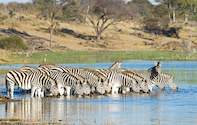
At Leroo La Tau, Makgadikgadi, Botswana, the hugely contrasting seasons and terrain make this area a unique haven for large herds and predators alike. This Botswana safari lodge is situated on the edge of the Makgadikgadi National Park.
Access is by road from Maun and takes about 1 and a half hours, 4x4 vehicles are needed for the last 6km (4 miles). Light aircraft flights to a landing strip are available, followed by a 30 minute road transfer to Leroo La Tau.
The Park was once covered by a vast inland sea. Now, the Park contains the salt pans, which is all that is left of the dried up sea, interspersed with low-lying grasslands. The dry Makgadikgadi Pans, which are situated in part of the south, east and north-eastern areas of the Park, fill with water in the rainy season in November, mostly retaining their water into April or May.
The pans are transformed into great sheets of water attracting a spectacular array of waterbirds and triggering dramatic migrations. The incredible beauty of this area can only be witnessed from the air as roads in these parts become inaccessible at this time.
After the start of the rainy season in November, this desert area fills up with wildlife as herds of zebra and wildebeest graze contentedly on the wide open green grassland plains of Makgadikgadi, Botswana. There is an influx of migratory bird species and resident desert birds show off their breeding plumage.
With the coming of the dry season, this area supports up to 30 000 wildebeest and zebra. These herds remain here after their migration in search of wet season grazing. Predator activity levels also increase at this time. It is not unusual to witness a stampede while the predators hunt around the lodge.
Leroo La Tau is situated on a cliff, overlooking the perennial Boteti Riverbed, bordering the National Park. During the dry season the river is reduced to nothing more than a waterhole, which is like a magnet for wildlife.

